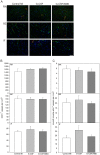Combinatorial G-CSF/AMD3100 treatment in cardiac repair after myocardial infarction
- PMID: 25121738
- PMCID: PMC4133256
- DOI: 10.1371/journal.pone.0104644
Combinatorial G-CSF/AMD3100 treatment in cardiac repair after myocardial infarction
Abstract
Aims: Several studies suggest that circulating bone marrow derived stem cells promote the regeneration of ischemic tissues. For hematopoietic stem cell transplantation combinatorial granulocyte-colony stimulating factor (G-CSF)/Plerixafor (AMD3100) administration was shown to enhance mobilization of bone marrow derived stem cells compared to G-CSF monotherapy. Here we tested the hypothesis whether combinatorial G-CSF/AMD3100 therapy has beneficial effects in cardiac recovery in a mouse model of myocardial infarction.
Methods: We analyzed the effect of single G-CSF (250 µg/kg/day) and combinatorial G-CSF/AMD3100 (100 µg/kg/day) treatment on cardiac morphology, vascularization, and hemodynamics 28 days after permanent ligation of the left anterior descending artery (LAD). G-CSF treatment started directly after induction of myocardial infarction (MI) for 3 consecutive days followed by a single AMD3100 application on day three after MI in the G-CSF/AMD3100 group. Cell mobilization was assessed by flow cytometry of blood samples drawn from tail vein on day 0, 7, and 14.
Results: Peripheral blood analysis 7 days after MI showed enhanced mobilization of white blood cells (WBC) and endothelial progenitor cells (EPC) upon G-CSF and combinatorial G-CSF/AMD3100 treatment. However, single or combinatorial treatment showed no improvement in survival, left ventricular function, and infarction size compared to the saline treated control group 28 days after MI. Furthermore, no differences in histology and vascularization of infarcted hearts could be observed.
Conclusion: Although the implemented treatment regimen caused no adverse effects, our data show that combinatorial G-CSF/AMD therapy does not promote myocardial regeneration after permanent LAD occlusion.
Conflict of interest statement
Figures





References
-
- Guo Y, Graham-Evans B, Broxmeyer HE (2006) Murine embryonic stem cells secrete cytokines/growth modulators that enhance cell survival/anti-apoptosis and stimulate colony formation of murine hematopoietic progenitor cells. Stem Cells 24: 850–856. - PubMed
-
- Yu RY, Wang X, Pixley FJ, Yu JJ, Dent AL, et al. (2005) BCL-6 negatively regulates macrophage proliferation by suppressing autocrine IL-6 production. Blood 105: 1777–1784. - PubMed
Publication types
MeSH terms
Substances
LinkOut - more resources
Full Text Sources
Other Literature Sources
Medical

